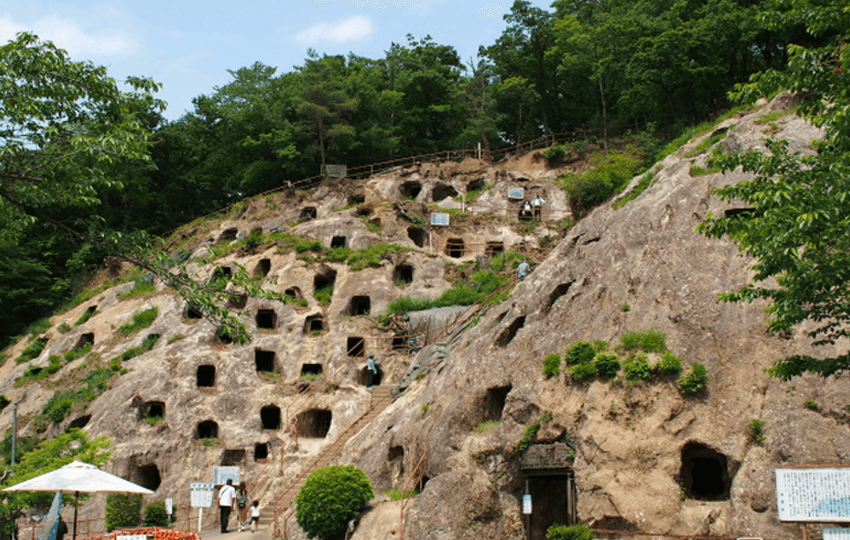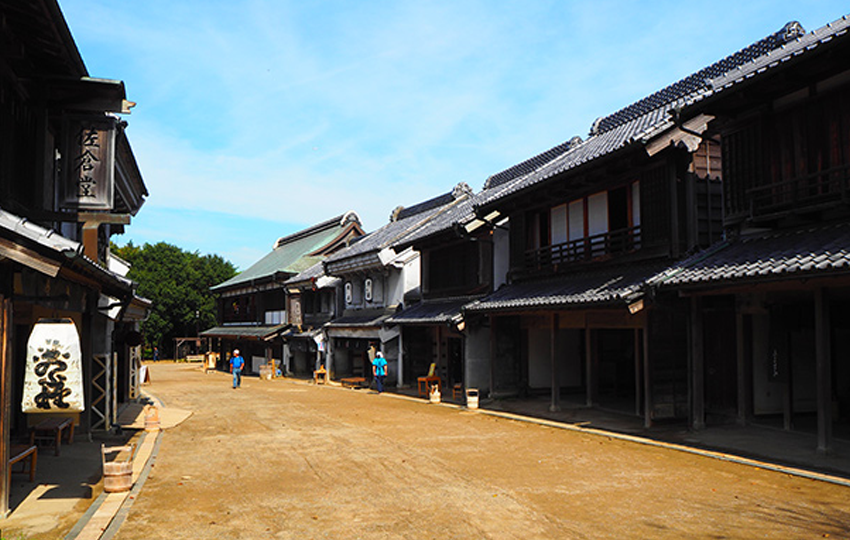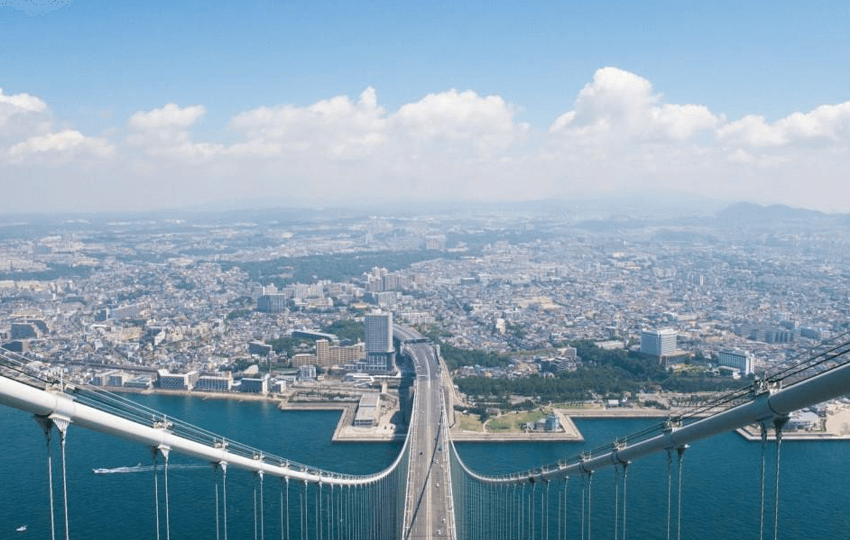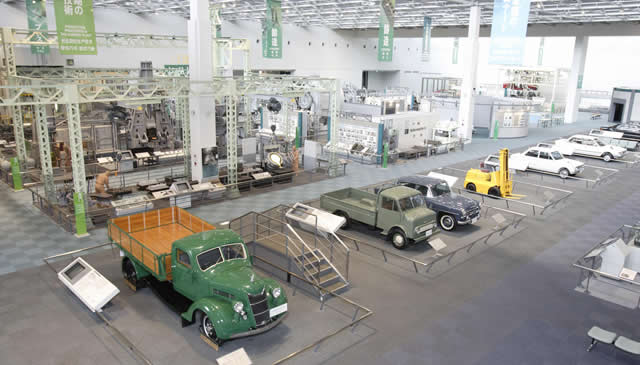-
[From April Issue 2015]
This unique and ancient burial mound consists of numerous caves dug into the rocky hillside. It’s thought that many caves are horizontal burial pits dating from the late Kofun era (6-7th centuries) and at the time of writing 219 have been counted as such. It’s possible to enter some of the caves, while others with their naturally-occurring luminous moss – designated as a protected species – can be viewed and photographed from behind a fence. In the springtime cherry blossoms can be enjoyed on the Hyakuana burial grounds and its environs. There is also a cave built to house a munitions factory during World War II that is often used as a location for television dramas.
Directions: Take the Tobu line to Higashi-Matsuyama Station. Then take the Kawagoe Kanko Bus heading towards Konosu License Center and get off at the “Hyakuana Iriguchi (entrance)” stop. From there it is only a five minute walk. Or you can take the JR Takasaki Line to Konosu Station, then take the Kawagoe Kanko bus bound for Higashi-Matsuyama Station and get off at the “Hyakuana Iriguchi” stop. From there it is only a five minute walk.
Hours of Operation: 8:30 a.m. to 5 p.m.
Entrance fees: 300 yen for adults and children of junior high school age or over, 200 yen for elementary students and free to children not yet in elementary school.
Open 365 days a year
Yoshimi-Hyakuana
Text: KAWARATANI Tokiko[2015年4月号掲載記事]岩山一面にたくさんの穴が見られるユニークな古墳群。古墳時代末期(6~7世紀)の横穴墓と考えられ、確認されているだけで219個。中に入れる横穴もある。国指定の天然記念物ヒカリゴケが自生している横穴もあり、フェンス越しでの撮影が可能。春は百穴構内と付近の桜が楽しめる。第二次世界大戦中に軍需工場目的で掘られた洞窟があり、テレビドラマなどのロケによく使われている。
交通:東武東松山駅下車。川越観光バス鴻巣免許センター行き「百穴入口」下車、徒歩5分、または、JR高崎線鴻巣駅下車 川越観光バス東松山駅行き「百穴入口」下車、徒歩約5分
入園時間:午前8時30分~午後5時
入園料:中学生以上300円 小学生200円 小学生未満無料
年中無休
吉見百穴
文:瓦谷登貴子 -
[From March Issue 2015]
Boso-no-Mura
Run by local government, Boso-no-Mura is a theme park located in Chiba Prefecture. It’s a 20 minute drive away from Narita International Airport. There you can experience the traditional lifestyle and crafts of Boso – the peninsula that covers the greater part of Chiba Prefecture. The theme-park covers an area of 51 hectares and is 11 times as big as Tokyo Dome. At its center is Boso-no-Mura where a project to grow and promote Edo era (17-19th centuries) vegetables has got underway.
Lots of vegetables used by people in Edo (the former name for Tokyo) were grown in the Hokuso Area (northern part of Chiba Prefecture which includes Narita City and Katori City). Vegetables eaten in Edo during the Edo period were called “Edo vegetables.” For the current project they are cultivating four kinds of vegetables: carrots, daikon (Japanese white radish), turnips, and Japanese mustard. Although they are not exactly the same varieties as those grown in that period, strains were selected that were as close as possible to those used.
Compared to modern-day vegetables that tend to have a standard size, appearance and harvesting season, Edo vegetables were quite diverse. As productivity is paramount in modern-day agriculture, selective breeding has advanced to the extent that Edo vegetables are no longer cultivated. However, as Edo vegetables are rich in fibre, sweet and strong tasting, they are delicious in soups and pickles.
In Boso-no-Mura, you can try your hand at harvesting Edo vegetables. Furthermore, at a nearby affiliated restaurant, the menu has been designed so visitors can enjoy eating these vegetables either boiled or pickled. GUO Chuanyu, a Chinese citizen who took part in the activity says, “Since I have hardly ever harvested daikon and carrots, it was a lot of fun. The Edo vegetables were delicious, too.”
Project manager OGASAWARA Nagataka says, “With Edo vegetables, cooperation within the region is growing. Some farming families, people who have their own kitchen gardens, and schools are now growing Edo vegetables. From now on, I would like to cooperate with people living in other areas too; by promoting Edo vegetables to people living in cities and to tourists from overseas, hopefully they will participate in our agriculture experience program. As these cultural exchanges blossom, it would be nice if that regenerated our local economy.”
The town of Sawara is a 30 minute drive away from Boso-no-Mura. The town’s shipping trade prospered during the Edo period and some of its streets from that time are still intact. Also of interest is the house of INO Tadataka, the first person to complete a map of Japan based on surveyed measurements. Nearby, too, is Katori Shrine, a location thought to be filled with spiritual energy. By not only experiencing Edo vegetables, but also by walking the streets of this old town, you’ll feel as if you’ve slipped back in time.
Boso-no-Mura
Text: KONO Yu[2015年3月号掲載記事]房総のむら
千葉県に「房総のむら」という県立のテーマパークがあります。場所は成田国際空港から車で約20分。房総(千葉県の大部分を占める、房総半島エリア)の伝統的な生活様式や技術を体験することができます。広さは約51ヘクタール、東京ドーム約11個分です。房総のむらを中心に、江戸時代(17~19世紀)の野菜を育てて広めようというプロジェクトが始まっています。
江戸で暮らす人たちの野菜は、北総地域(成田市や香取市など、千葉県の北側エリア)で盛んに作られていました。江戸時代に江戸の町で食べられていた野菜を、「江戸野菜」と呼びます。今回のプロジェクトでは、ニンジン、大根、カブ、小松菜の4種類を育てています。当時と全く同じ品種ではないのですが、なるべく近いものを選んでい
ます。
江戸野菜と現代で採れる野菜を比べると、現代の野菜は大きさ、見た目、収穫時期が均一なのに対して、江戸野菜は全てがばらばらです。そのため、効率を重視する現代農業では、品種改良が進み、作られなくなってしまいました。しかし、江戸野菜の繊維は細かく、味は甘くて濃く、煮物や漬物にすると、とてもおいしいのです。
房総のむらでは、江戸野菜の収穫などの農業体験ができます。さらに、提携している近くのレストランでは、煮物や漬物で食べることができるよう、メニューを開発しています。体験に参加した中国人の郭伝宇さんは、「大根やニンジンの収穫作業はなかなか体験できないのでとても楽しかったです。江戸野菜もすごくおいしかったです」と話します。
このプロジェクトの担当者である小笠原永隆さんは、「江戸野菜を通じて地域の連携が広がっています。いくつかの農家や家庭菜園、学校では既に江戸野菜を育てています。今後はもっと多くの地域と連携しながら、都市に住んでいる人や、外国人観光客にもっと江戸野菜を知ってもらい、農業体験に参加していただきたいです。人々の交流が盛んになることで、地域経済を活性化させたいですね」と話します。
房総のむらから車で30分ほどのところに佐原という町があります。江戸時代に海運で栄え、当時の街並みが多く残っています。江戸時代に日本国中を測量してまわり、初めて実測による日本地図を完成させた伊能忠敬が住んでいた家などもあります。また、パワースポットで知られる香取神宮(香取市)も近くにあります。江戸野菜の体験だけでなく古い街並みを歩いてみると、自分がその時代に存在しているかのような気分を味わうことができます。
房総のむら
文:河野有 -
[From March Issue 2015]
Due to the huge economic impact of high speed shinkansen trains, sleeper trains in Japan are about to disappear. One of the enjoyable things about sleeper trains is the time spent riding on them. Although they were once a means of transportation for students reluctant to spend too much on traveling expenses, sleeper trains today have become a luxurious space for people with both money and time to spend on traveling. Many people are sad to see the discontinuation of the sleeper trains which had a charm that set them apart from ordinary means of transportation.
This March two sleeper trains linking Hokkaido and Honshu will be discontinued. The final run of the “Twilight Express” running from Osaka Station to Sapporo Station along the coast of the Sea of Japan will be on the 12th, while the final run of the “Hokutosei” running from Ueno Station to Sapporo Station along the Pacific coast will be on the 13th. From April to August, a special Hokutosei train service will operate once every two or three days.
There were 39 so called “Blue Train” sleeper trains – painted with a blue exterior – in operation in Japan. The Hokutosei is the last one. The news of its discontinuation surprised even those who weren’t particularly interested in trains. A large number of people want to ride on it at least once before the service is shut down. The occupancy rate of the trains is higher compared to last year.
Dinner is served in the dining car (reservations required), at 6,000 or 8,500 yen a head. The set menus are popular despite being expensive. Long queues form during bar hours when no reservation is required for entry. Since it was decided that the service would be discontinued, people want to buy the original products sold while the train passes through Hokkaido as a souvenir of their last ride. So, now they’ve become hard to get hold of.
At terminuses, many people – including non-passengers –take pictures of the carriages and of the signature plate affixed to the train’s nose. To capture the best shots, some wait for the train at stations where the train does not stop or at curves in mountainous areas. At Hakodate Station, where the train stops for a longer period of time to switch engines, quite a few passengers descend onto the platform with cameras to photograph the scene.
In the past, Blue Trains on other lines were discontinued mainly because of the decreasing number of passengers and the increasing age of the cars. This time, the discontinuation is due to ageing of the cars and the imminent introduction of the Hokkaido Shinkansen. SUZUKI Takafumi of the PR department of JR Hokkaido points out that “the cost to get new cars would be tremendous.” Train carriages that retain an old world atmosphere are attractive, but it’s becoming hard to repair parts and furnishings.
The Hokkaido Shinkansen is scheduled to begin operating in March, 2016. This high speed train is going to operate under different conditions from other shinkansen routes in that it will share a rail track with conventional trains and operate in the coldest part of Japan. “Many different inspections and tests will be carried out in an extremely limited period of time overnight, so it might be necessary to modify the night train timetable,” says Suzuki.
The advantage of the shinkansen is that it’s a speedy and convenient way to travel. It’s expected that the Hokkaido Shinkansen will have a huge impact. “You’ll be able to travel quickly from the Tokyo Metropolitan Area to Hokkaido without changing trains. This will have a positive influence on tourism not only in southern Hokkaido where the shinkansen will be running, but also across the whole of Hokkaido. Ties between Tohoku and Hokkaido will strengthen further,” says Suzuki.
JR Hokkaido
Text: ICHIMURA Masayo[2015年3月号掲載記事]
大きな経済効果を生む新幹線の陰で寝台特急が消えようとしています。寝台特急は乗車している時間そのものが楽しみの一つです。かつてはあまり旅費をかけたくない学生の乗り物でしたが、現在では移動にお金と時間をかけられる人が乗るぜいたくな空間になっています。単なる移動手段としてではない魅力を持った寝台列車の廃止を多くの人が惜しんでいます。
今年3月、北海道と本州をつなぐ2本の寝台列車が廃止になります。日本海側を通り大阪駅から札幌駅を走行する「トワイライトエクスプレス」は12日が最終走行、太平洋側を走行し上野駅から札幌駅を結ぶ「北斗星」は13日が定期列車としての最後の運行になります。北斗星は4月以降8月までは臨時列車として2、3日に1回程度の割合で運行されます。
日本には「ブルートレイン」と言われる寝台列車が39本走っていました。北斗星は最後の路線です。廃止決定のニュースは列車に特に関心のない人も驚かせました。廃止前に一度は乗りたいという人は多く、予約率は昨年に比べてアップしています。
食堂車のディナー(予約制)は6,000円または8,500円。高額ですが人気です。予約なしで入れるパブタイムには長い列ができます。道内走行中に車内販売されるオリジナルグッズは、廃止が決まってから記念品として求める人が増えました。そのため現在では入手困難になっています。
始発駅では、乗車しない人を含め多くの人が車体やヘッドマークを撮影しています。通過駅や山間部のカーブで列車を待ち、ベストショットを狙っている人もいます。牽引機関車を交換するため停車時間が長い函館駅では、乗客の多くがカメラを持ってホームに降り、その様子を写真に収めています。
これまでブルートレインの廃止の理由は利用者の減少と車両の老朽化が主でした。今回は老朽化と北海道新幹線開業が関係しています。JR北海道広報部の鈴木隆史さんは「車体を新しいものにしようとすると莫大な金額がかかります」とコスト面での問題をあげます。運行を始めた当時の雰囲気を残した車体には味がありますが、修理のための部品や備品は入手困難になりつつあります。
北海道新幹線は来年3月末までの開業が予定されています。この新幹線は今までの新幹線とは異なり、在来線と線路を共有し、日本で一番寒い地域を走ります。そのため「夜間の極めて限られた時間内でさまざまな検査や試験を行うので、夜間走行する列車の運転計画の調整が必要になっています」と鈴木さんは話します。
新幹線の長所は、早く、便利に移動できることです。北海道新幹線には大きな役割が期待されています。「首都圏から乗り継ぎなしで早く北海道へ行けるようになります。観光面では新幹線の通る道南だけでなく、北海道全域にとっても良い効果があります。東北と北海道の交流もますます盛んになるでしょう」と鈴木さんは言います。
文:市村雅代
-
[From March Issue 2015]
This is a tour of the Akashi-Kaikyo Bridge, the biggest suspension bridge in the world. A talk explaining how this 3,911 meter bridge was constructed between Kobe City, Hyogo Prefecture and Awaji-shima Island will be given. Audio guides in English, Chinese and Korean are lent out for free. To get a sense of the height and size of the bridge, participants are invited to walk along the inspection passage inside the bridge, which is usually closed to members of the public. The highlight of the tour comes at the end with a 360-degree view in the main tower 300 meters above sea level.
Meeting place: Akashi-Kaikyo Bridge Exhibition Center (five minutes’ walk from Maiko Station on the JR Kobe Line)
Period: From Thursday to Sunday and on national holiday days during the months of April to November.
Tours are held twice a day (from 9:30 a.m. and from 1:30 p.m.).
Reservations can be made from 10:00 a.m on the first day of the month two months before your preferred date.
Price: 3,000 yen for adults and 1,500 yen for junior high school students
ID is required.
The maximum number accepted per reservation is five. Groups of six or more need to appoint another representative for additional reservations.
In the case of heavy rain or strong wind the tour may be canceled on the day if the administrator decides it is difficult to proceed.Bridge World at Akashi-Kaikyo (Akashi Strait) Bridge[2015年3月号掲載記事]
世界最大のつり橋、明石海峡大橋の見学ツアー。兵庫県にある神戸市と淡路島にかかる、橋長3,911メートルの建設の話が聞ける。英語、中国語、韓国語のオーディオガイドが無料で貸し出し可能。通常は入れない橋の内部に入り、管理用通路を歩いて高さと大きさを体感。最後は、海面上約300メートルの主塔から360度の景色が見られる。
集合場所:橋の科学館(JR神戸線舞子駅より徒歩約5分)
開催期間:4~11月の木~日曜、祝日
1日2回(午前9時30分と午後1時30分)
希望日の2ヵ月前の1日、午前10時から予約開始。
料金:大人3,000円 中学生1,500円
身分証明できるものが必要。
グループの場合は5名まで。6名以上は代表者を替えて追加申込みが必要。
当日、大雨や強風などの影響により、事務局が実施困難と判断した場合は中止。
明石海峡大橋 ブリッジワールド -
[From February Issue 2015]
Ohkunoshima in Takehara City, Hiroshima Prefecture
Japan is a country consisting of roughly 6,800 small and large islands. Some of these are inhabited by large populations of certain animals. For instance, Tashirojima in Miyagi Prefecture and Aoshima in Ehime Prefecture are known as cat islands and deer roam free at Itsukushima (or Miyajima) in Hiroshima Prefecture. Home to over 700 rabbits, Ohkunoshima in Takehara City, Hiroshima Prefecture, is one such island.
Covering an area of about 0.7 square kilometers, Ohkunoshima is an island in the Seto Inland Sea. It’s 12 to 13 minutes away by ferry from Tadanoumi Port in Hiroshima Prefecture or Sakari Port in Omishima, Ehime Prefecture. The island has several hotels, hot springs, and various leisure facilities including tennis courts and swimming pools. You can also enjoy bathing in the sea, fishing and sea firefly viewing. There is a camp site as well, where camping supplies are available for rent.
Until the end of World War II, there was a Japanese military facility producing poison gas on Ohkunoshima. In addition to the Poison Gas Museum, remains of gun batteries and factories from those days can still be found on the island. This makes Ohkunoshima a good place to learn about the importance of peace and about the history of the war.
The main means of transportation on Ohkunoshima are free buses that run very slowly or rental bicycles. You are not allowed to drive your own car on the island. Tourists who have driven there have to park their cars in the parking lot at the port or in parking spaces on the island. With the exception of service dogs, it’s forbidden to bring animals onto the island. In an environment with no traffic and few predators, rabbits live peacefully.
The rabbit that inhabits Ohkunoshima is a species native to Northern Africa and Europe called the European rabbit. They were brought into Japan as pets, livestock, and experimental subjects. It’s unknown why there are so many of them on Ohkunoshima now, but the prevailing theory is that eight rabbits kept as pets at a local elementary school were set free in 1971, went feral and multiplied.
A number of people visit Ohkunoshima several times a year just to see the rabbits. Some can be seen enthusiastically taking pictures of them. Pictures and videos of the Ohkunoshima rabbits have been much discussed in other countries as well, so the island also attracts foreign tourists.
KADOWAKI Hirokazu of Kyuukamura Ohkunoshima (National Park Resort Ohkunoshima) says: “Rabbits are weak animals. They tend to get stressed easily, so please do not chase them around or pick them up. If they get sick or injured, they won’t be able to live in the wild. Also, rabbits that have been kept in captivity can’t survive in the harsh natural environment. Please refrain from leaving rabbits and other animals on the island.”
Kyuukamura Ohkunoshima
Text: SAZAKI Ryo[2015年2月号掲載記事]広島県竹原市大久野島
日本は大小合わせて約6,800の島からなる国です。それらの中には、特定の動物が多くいる島があります。例えば、ネコ島として知られる宮城県の田代島や愛媛県の青島、シカが多い広島県の厳島(宮島)などです。大久野島(広島県竹原市)も、そのような島の一つで、700羽以上のウサギがいます。
大久野島は瀬戸内海に浮かぶ、面積約0.7平方キロメートルの島です。広島県の忠海港または愛媛県大三島の盛港からフェリーで12~13分です。宿泊施設や温泉、テニスコート、プールなどのレジャー施設があります。海水浴や釣り、海ホタルの観察なども楽しめます。キャンプ場もあり、キャンプ用品の貸し出しも行っています。
大久野島には第二次世界大戦が終わるまで日本軍の施設があり、毒ガスの生産が行われていました。島の中には砲台や工場の跡が残っており、毒ガス資料館も建てられています。そのため大久野島は、平和の貴さや歴史を学ぶための場所としても利用されています。
大久野島内の主な交通手段は、とてもゆっくりと走る無料バスか、またはレンタサイクルです。島内で自分の車を運転することはできません。車でやってきた観光客は、港の駐車場か島内の駐車スペースに車を停めます。動物の持ち込みは、介助動物以外は禁止されています。このように車の通行もなく、天敵の動物も少ない環境で、ウサギたちはゆったりと暮らしています。
大久野島のウサギはアナウサギと呼ばれる種類で原産地は北アフリカからヨーロッパにかけての地域です。日本にはペットや食肉用、実験用動物として入ってきました。なぜ大久野島にたくさんいるのかは不明ですが、地元の小学校でペットとして飼われていたウサギ8羽が1971年に放され、野生化してふえたという説が有力です。
ウサギ目当てに、年に何度も大久野島を訪れる人もいます。ウサギの写真を熱心に撮る人も見られます。大久野島のウサギの写真や動画は海外でも話題になったため、外国人観光客も訪れるようになりました。
休暇村大久野島の門脇広和さんは話します。「ウサギは弱い動物です。ストレスがたまりやすいため、追いかけ回したり抱っこしたりしないでください。病気やけがをすると野生の環境で暮らせなくなってしまいます。また、飼育されていたウサギは厳しい自然環境の中で暮らしていくことができません。ウサギに限らず島に生き物をおいて帰ることはやめてください」。
休暇村大久野島
文:砂崎良 -
[From February Issue 2015]
This is the first malt whiskey distillery to be constructed in Japan. One of the whiskeys manufactured here is “Single Malt Whiskey Yamazaki” which has received awards at various alcoholic beverage competitions around the world. A guided tour (free of charge, reservations required) explains the whiskey making process and attracts many visitors. At the Whiskey Museum you can taste about 100 different brands of whiskeys, including rare unblended whiskeys and limited edition whiskeys, for a fee.
Access: 10 minutes’ walk from Yamazaki Station of JR Kyoto Line or Oyamazaki Station of Hankyu Kyoto Line
Yamazaki Whiskey Museum
Opening hours: From 10:00 a.m. to 4:45 p.m. (Last admission: 4:00 p.m.)
Yamazaki Distillery Guided Tours
begin every 60 minutes from 10:00 a.m. to 3:00 p.m. on weekdays.
On Saturdays, Sundays and holidays they begin every 30 minutes from 10:00 a.m. to 12:00 p.m.
An audio guide is available in English, Chinese and French.
Admittance: Free of charge
Closing days: Year-end and New Year holidays, factory holidays (and during temporary closures)
Suntory Yamazaki Distillery[2015年2月号掲載記事]日本初のモルトウイスキー蒸溜所。世界のさまざまな酒類コンペティションで受賞した「シングルモルトウイスキー山崎」などを生み出している。ウイスキーの製造工程がわかるガイドツアーが人気(無料、要予約)。ウイスキー館では、珍しいウイスキーの原酒や数量限定のウイスキーなど約100種類が試飲できる(有料)。
交通:JR京都線山崎駅、阪急大山崎駅より徒歩約10分
山崎ウイスキー館
開館時間:午前10時~午後4時45分(最終入館午後4時)
山崎蒸溜所ガイドツアー
平日午前10時~最終回午後3時(60分毎)
土日祝日午前10時~最終回午後12時(30分毎)
英語、中国語、フランス語のイヤホンガイドの貸し出しあり。
料金:無料
休館日:年末年始、工場休業日(臨時休業あり)
サントリー山崎蒸溜所 -
[From January Issue 2015]
This is the world’s first public museum of bonsai art. Seasonal bonsai are exhibited inside the museum building and in the garden. Audio guide devices in Japanese, English, Korean and Chinese are available to rent. Many workshops and themed exhibitions are organized here. Paintings to celebrate the New Year will be on display from December 13 to January 21, 2015. Around the museum, six bonsai gardens are located, where you can enjoy bonsai throughout the day.
Access: five minute walk from the east exit of Toro Station on the JR Utsunomiya Line
Opening hours:
November – February: 9:00 a.m. – 4:00 p.m.
March – October: 9:00 a.m. – 4:30 p.m.
Admission for the general public: 300 yen
Closed days: every Thursday and December 29 – January 3
The Omiya Bonsai Art Museum, Saitama [2015年1月号掲載記事]世界で初めての公立盆栽美術館。館内と庭園には、季節ごとの盆栽を展示。音声ガイド(日本語、英語、韓国語、中国語)の貸し出しが可能(有料)。ワークショップや、企画展示もたくさん開催している。12月13日から2015年1月21日には、お正月を祝う絵画なども展示。美術館周辺には6軒の盆栽園があり、1日中盆栽が楽しめる。
交通:JR宇都宮線土呂駅下車東口より徒歩5分
開館時間
11月~2月:午前9時~午後4時
3月~10月:午前9時~午後4時30分
一般料金:300円
休館日:木曜日、年末年始(12月29日~1月3日)
さいたま市大宮盆栽美術館 -
[From Decemberber Issue 2014]
This restaurant theater opened in April this year. Wahaha Hompo, a troupe known for its eccentric costumes and performances is now giving its first performance of Gorakuza” (Entertainment Theater) – an original work specially made for the theater. (Admittance: 4,500 yen. On top of this customers must order at least one drink.) Including characters and music that will even be familiar to non-Japanese, this is a show that everyone can enjoy. In addition there is a permanent exhibition of Asakusa’s streets reproduced on panels and in dioramas, the “Secret Hideout of About 100 Square Meters” (costs 500 yen), and screenings of movies associated with the town (1,000 yen).
Access: Four-minute walk from the A1 exit of Taharacho Station on the Tokyo Metro Ginza Line
Address: ROX1F Entrance, 1-25-15 Asakusa, Taito Ward, Tokyo
Business hours: 9:30 a.m. – 9:00 p.m. (depending on the program)
Asakusa Rock Yumemachi Theater
Text: KAWARATANI Tokiko[2014年12月号掲載記事]今年4月にオープンした、レストランシアター。奇抜な衣装やパフォーマンスが特徴の劇団「ワハハ本舗」が、当劇場用に「娯楽座」を旗揚げして公演中(料金:4,500円、別途1ドリンクオーダー必要)。外国人にもなじみのある人物や音楽を取り入れ、誰でも楽しめる内容にしている。浅草の町をパネルやジオラマで再現した常設展「三十坪の秘密基地」(500円)や、浅草にちなんだ映画の上映(1,000円)もある。
交通:東京メトロ銀座線田原町駅A1出口徒歩約4分
所在地:東京都台東区浅草1-25-15 ROX1F専用入口
営業時間:午前9時30分~午後9時(演目によって異なる)
浅草六区ゆめまち劇場
文:瓦谷登貴子 -
ロリータファッションでまちおこし
- Hiragana Times
- May 25, 2015
[From Novemberber Issue 2014]
The city of Otaru in Hokkaido is known for its beautiful streets. A new type of tourism event called the “Otaru Kawaii Tea Party” was created there. Aimed at fans of Lolita fashion, it’s been held since last year.
Lolita fashion is about clothing with frills and lace attached that resembles the outfits once worn by modern Western women. Young women started up the Lolita fashion trend, which is characterized by its antique design. As part of Japanese pop culture, it’s been gaining fans around the world.
In 2012, a contest was held in Sapporo City for business ideas that might revitalize the city. The winner was a plan to make use of the Lolita fashion trend. Lolita fashion goes well with the historical cityscape of Otaru. Putting this idea into practice, a decision was made for the city of Otaru and the local tourism association to host events.
This year, 73 people took part. They strolled along a canal and through old streets, all the while enjoying photo opportunities. A fashion show – eating cakes and so forth – took place at a nearby stone warehouse which had been repurposed as a live music hall. Many participants expressed a wish that the event would continue in the future. The participants weren’t only young Japanese women; men and foreigners also took part.
“Many people told me they were happy there was a new place to enjoy Lolita fashion,” says MITSUHASHI Asako, head of the Lolita fashion brand “Kita Loli,” which helped to organize the event. Otaru City’s aim is to spread awareness of Otaru’s scenery alongside Lolita fashion. With this in mind, they’re hoping to spark the interest of many other kinds of people.
“Just as people try on maiko (trainee geisha) costumes when they go to Kyoto, I’d like people to try on Lolita outfits when they come to Otaru. I’d like to firmly establish it as part of our interactive tourism,” says NAKANO Hiroaki of the Sightseeing Promotion Room of Otaru City. In the city hopes have been raised that Otaru’s sweets and fashion will also be promoted.
These days, there are more and more inquiries not only from domestic media, but also from Chinese media and French media. In Hong Kong, too, more people are paying attention to Lolita fashion. Hokkaido is already a popular tourist spot with South East Asians. In the future, Lolita fashion may end up becoming one of Hokkaido’s tourist attractions.Text: TSUCHIYA Emi
[2014年11月号掲載記事]
北海道小樽市は、美しい街並みで知られています。ここで、新しい形の観光イベント「小樽kawaiiティーパーティー」が生まれました。ロリータファッションのファンを対象に昨年から行われています。
ロリータファッションとは、かつて近代西洋の女性が着ていたようなフリルやレースがついた服のことです。古風なデザインが特徴で、若い日本人女性の間で始まりました。日本のポップカルチャーの一つとして、世界中にファンが増えています。
2012年に札幌でまちおこしのためのビジネスコンテストが開催されました。優勝したのがロリータファッションを活用した企画です。ロリータファッションは小樽の歴史的なまちに合います。小樽市や観光協会などがこのアイディアを使ったイベントを実施することになりました。
今年は73人が参加。写真撮影を楽しみながら運河沿いや古い街並みを散策しました。その後は近くのレンガ造り倉庫を利用したライブハウスで行われるファッションショーを見ながらケーキなどを食べます。参加者からは今後も開催してほしいという要望が多くよせられました。若い女性だけでなく男性や外国人の参加者もいます。
「ロリータファッションを楽しめる場ができてうれしかったとの声が多かったです」。イベントの開催に協力したロリータファッションブランド「北ロリ」の代表、三橋朝琴さんは言います。小樽市の狙いは、ロリータファッションとともに小樽の景観が広く紹介されることです。そのため、たくさんの人に興味をもってほしいと考えています。
「京都へ行ったときに舞妓の衣装を着てみるのと同じ様に、小樽へ来たときにはロリータの衣装を体験してもらいたいのです。今後は体験観光の一つとして定着させたいです」と小樽市観光振興室の中野弘章さんは話します。市では小樽のスイーツやファッションなどのPRにつながる期待も高まっています。
最近は国内だけでなく中国やフランスのメディアからの問い合わせも増えています。香港にもロリータファッションに注目している人が増えています。また、北海道はもともと東南アジアの人たちに人気の観光地です。今後は北海道名物の一つとしてロリータファッションが定着するかもしれません。
文:土屋えみ
-
[From Novemberber Issue 2014]
This memorial museum utilizes the Meiji era factory where Toyota first originated. A total of 13 buildings and artifacts were designated in 2007 by the Japanese government as part of the country’s Industrial Modernization Heritage. Starting with the invention of the weaving loom and including its endeavors with domestic automobile production, it’s possible to learn about the company’s history. A violin performance by the Partner Robot, which made its debut at the Shanghai Expo, is also popular. Because there are cafes and kids’ areas, both children and adults can enjoy the facility all day long.
Access: Three minute walk from Sako Station on the Meitetsu Nagoya Line
Admission: Adults 500 yen / junior and senior high school students 300 yen / elementary school students 200 yen
Opening hours: 9:30 a.m. to 5:00 p.m. (admission until 4:30 p.m.)
Days museum is closed: Monday (Tuesday, if Monday is a holiday), year-end, and New Year’s holidays
Toyota Commemorative Museum of Industry and Technology
Text: KAWARATANI Tokiko[2014年11月号掲載記事]トヨタグループ発祥の地にある、明治時代の工場を活用した記念館。2007年には建物および所有物計13点が近代化産業遺産に認定された。織機の発明から始まり、国産自動車製造に取り組んだ歴史が学べる。上海万博でデビューしたパートナーロボットのバイオリン演奏も人気。館内にはカフェやキッズコーナーがあるので、子どもから大人まで1日中楽しめる。
交通:名鉄名古屋本線栄生駅より徒歩約3分
観覧料金:大人500円 中高生300円 小学生200円
開館時間:午前9時30分~午後5時(入場受付4時30分まで)
休館日:月曜(祝日の場合翌日)、年末年始
トヨタ産業技術記念館
文:瓦谷登貴子
Information From Hiragana Times
-
 February 2026 Issue
January 21, 2026
February 2026 Issue
January 21, 2026 -
 January 2026 Issue – Available as a Back Issue
January 15, 2026
January 2026 Issue – Available as a Back Issue
January 15, 2026 -
 December 2025 Issue —Available as a Back Issue
November 20, 2025
December 2025 Issue —Available as a Back Issue
November 20, 2025








